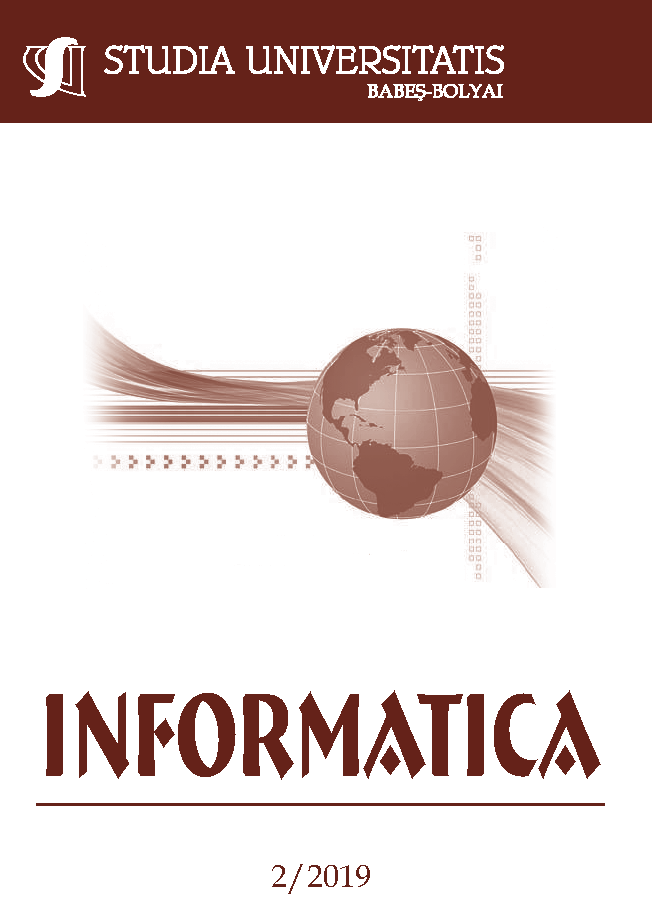AUTOMATION AND GAMIFICATION OF COMPUTER SCIENCE STUDY
DOI:
https://doi.org/10.24193/subbi.2019.2.07Keywords:
system architecture, education, automated verification, gamification.Abstract
A large part of the job of a university teacher in computer science is to verify student exercises. The task of verifying correctness, coding style, conventions, and grading is laborious and if done correctly leaves little time for questions. Automating aspects of this work helps all parties involved by freeing time up for questions. The solution detailed in the paper automates a number of these tasks and provides near instant feedback for the students, together with a platform to gamify student learning.
References
A. Aiken. Measure of software similarity: Plagiarism detection system. Technical report, Computer Science Division of University of California, 2002.
A. L.-W. O. B. Cheanga, A. Kurniaa. On automated grading of programming assignments in an academic institution. Computers & Education 41, pages 121 —- 131, 2003.
Y. L. B. Leong. Application of game mechanics to improve student engagement. In International Conference on Teaching and Learning in Higher Education. Citeseer, 2011.
S. Deterding, D. Dixon, R. Khaled, and L. Nacke. From game design elements to game-fulness: Defining gamification. Proceedings of the 15th International Academic MindTrek Conference: Envisioning Future Media Environments, MindTrek 2011, 11:9–15, 09 2011.
X. Fu, B. Peltsverger, K. Qian, L. Tao, and J. Liu. Apogee: automated project grading and instant feedback system for web based computing.
J. J.-D. G. G. Barata, S. Gama. Engaging engineering students with gamification. 2013 5th International Conference on Games and Virtual Worlds for Serious Applications, VS-GAMES 2013, pages 24–31, 09 2013.
D. A. G Gygax. Dungeons and dragons. TACTICAL STUDY RULES, 1974.
N. W. G.E. Forsythe. Automatic grading programs. Communications of the ACM, 8(5), pages 275–529, 1965.
J. Hamari, J. Koivisto, H. Sarsa, et al. Does gamification work? - A literature review of empirical studies on gamification. In HICSS, volume 14, pages 3025–3034, 2014.
S. Itamar. Using gamification and gaming in order to promote risk taking in the language learning process. MEITAL National Conference, pages 227 –– 232, 2015.
N. v. V. J. Hage, P. Rademaker. A comparison of plagiarism detection tools. Technical Report UU-CS-2010-015, 2010.
D. D. J. Taylor. Constructed-response, computer-graded homework. American Journal of Physics, 44, pages 598–599, 1976.
M. M. Striewe. A review of static analysis approaches for programming exercises. Computer Assisted Assessment. Research into E-Assessment., pages 100–113, 2014.
K. J. Majuri, Jenni and J. Hamari. Gamification of education and learning: A review of empirical literature. In Proceedings of the 2nd International GamiFIN Conference, GamiFIN 2018. CEUR-WS, 2018.
M. Poženel, L. Fürst, and M. Viljan. Introduction of the automated assessment of homework assignments in a university-level programming course. In 2015 38th International Convention on Information and Communication Technology, Electronics and Microelectronics (MIPRO), pages 761–766. IEEE, 2015.
B. A.-H. Q. Zoubi, I. Alsmadi. Study the impact of improving source code on software metrics. 2012 International Conference on Computer, Information and Telecommunication Systems (CITS), 2012.
H. H. R. M. Rottman. Computer grading as an instructional tool. Journal of college science teaching, 12, pages 152–165, 1983.
B. F. Skinner. Two types of conditioned reflex and a pseudo type. Journal of General Psychology 12, pages 66–77, 1935.
U. von Matt. Kassandra: The automatic grading system. ACM Special Interest Group on Computer Uses in Education Outlook, 22, 03 2001.
Downloads
Published
How to Cite
Issue
Section
License
Copyright (c) 2019 Studia Universitatis Babeș-Bolyai Informatica

This work is licensed under a Creative Commons Attribution-NonCommercial-NoDerivatives 4.0 International License.





